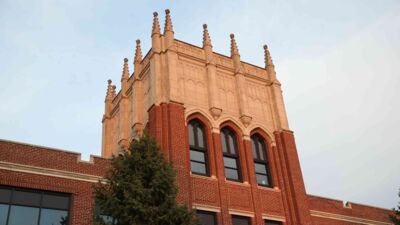Concordia Nebraska staff, students and alumni enjoy unforgettable New Zealand study tour

More than a dozen current and former Concordia Nebraska students recently enjoyed an unforgettable trip of a life time to New Zealand. Led by the university’s Assistant Professor of Agricultural Science Dr. Kimberly Clark and Chair of Department of History, Geography, Intercultural Studies and Modern Languages Dr. Joel Helmer, the trip included visit to multiple sites on the South Island including Milford Sound, Mt. Cook, Queenstown, Christchurch, Dunedin and more.
Attendees included Helmer and his wife Holly, Clark, Concordia Nebraska emeritus professor of Biology Dr. Joe Gubanyi and his wife Heidi, and recent university graduates Olivia Leising and Gabe Ellis as well as current students Jack Nelson, Kellie Rhodes, Carson Rathje, Jessie Ciezki, Sydney Schildt, Connor Ascher, Rylee Ladd, Elizabeth Ascher, Ty Swanson, Haley Schmutzer, Ellie Jander and Joel Rathe.
“The overarching goal for the study tour was to expose our students to international travel and culture while learning about the fascinating interplay between geography, agriculture, and environmental science,” explained Helmer.
The group departed December 27, 2023 and returned home January 7, 2024. The group flew from Omaha through Denver and then on to San Francisco. The flight from San Francisco to Christchurch, New Zealand is more than 13 hours, one of the longest commercial flights available. During the flight, the group crossed the International Date Line, meaning they landed on December 29.
One of the highlights of the trip included being some of the first people on earth to celebrate the New Year, due to their time zone orientation in New Zealand. The group rang in the New Year on the lakefront in Queenstown. Other adventures included visiting Milford Sound, a fjord that is a UNESCO World Heritage Site. The group took a cruise across the fjord and out into the Tasman Sea. Part of Fiordland National Park, this area of the Southern Alps exposed the students to glaciers and learning about and seeing glacial landforms.
“We visited multiple farming operations where the students met with local farmers and ranchers,” said Helmer. “We saw sheep shearing, dairy operations, a red deer farm, sheep dog herding demonstrations, an orchard, winery, and cattle operations. The students learned a great deal about how the environment and geography shape agricultural processes. We also compared and contrasted farming in the U.S. with farming in New Zealand.” Clark added, “students were able to see the intersection between geography, environmental science, agriculture, history, and culture while touring and exploring. We often forget the interaction and alliance that shape the culture and environment of a country.”
The current university students on the trip obtained geography, agriculture or environmental science credit for the trip.
“The opportunity (to go to New Zealand) allowed me to understand not only the many differences but more importantly the similarities that agriculture faces across the globe,” said Carson Rathje. “Farmers here and there both want to educate the public when it comes to realistic agricultural practices for their respective areas especially when balancing conservation, sustainability, and profitability all at once.”
The trip also included a visit to Mount Cook, the tallest mountain in New Zealand, located in Aoraki/Mount Cook National Park, which is home to New Zealand’s highest mountains and the longest glaciers. A hike in Hooker Valley to Mount Cook led the group along the Hooker River and crossing three swing bridges before ending at a glacial lake.
“We see physical and cultural geography from a new perspective and have a greater appreciation for understanding land formation and agriculture practices after the study tour,’ said Clark. “It isn’t every day you can stand in a valley and see lush trees growing on your left and a barren landscape on your right or a beach of smooth rock formed from basalt.”
“The New Zealand study tour was an incredible way to immerse myself in learning. When you’re in another country, you are constantly observing a way of life that is different from your own, which expands your perspective of the world,” said Concordia Nebraska education major Elizabeth Ascher. “I learned so much about the people, history, agriculture, and geography of New Zealand that I never would have known without traveling there.”
"New Zealand is a beautiful place in the world that no camera can capture. One must travel there to truly capture its beauty," added Joel Rathe, Concordia Nebraska biology and environmental science student.
Are you interested in learning more about Concordia Nebraska study tours and study abroad opportunities? Discover more here.
Related Stories


